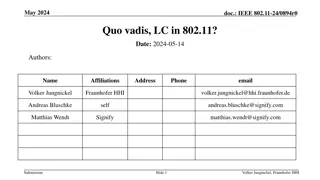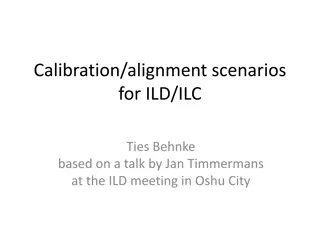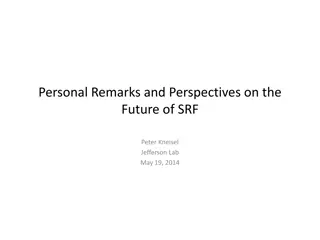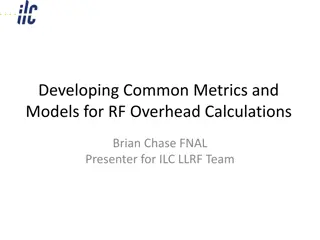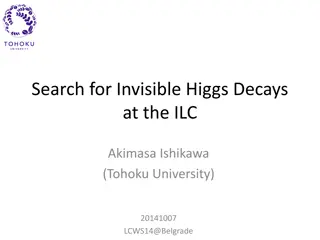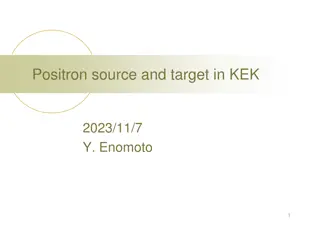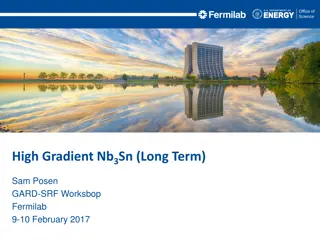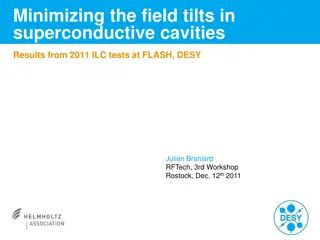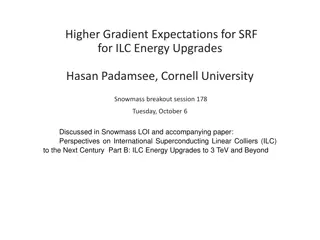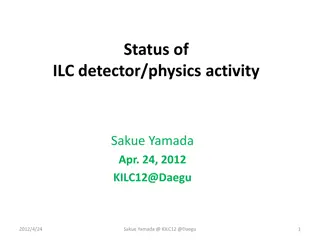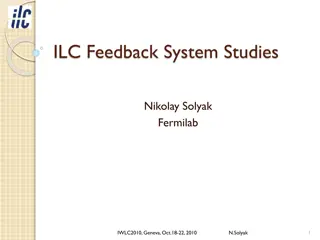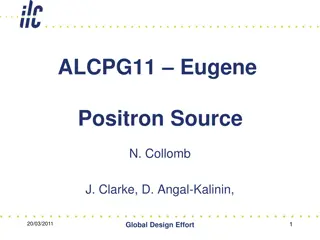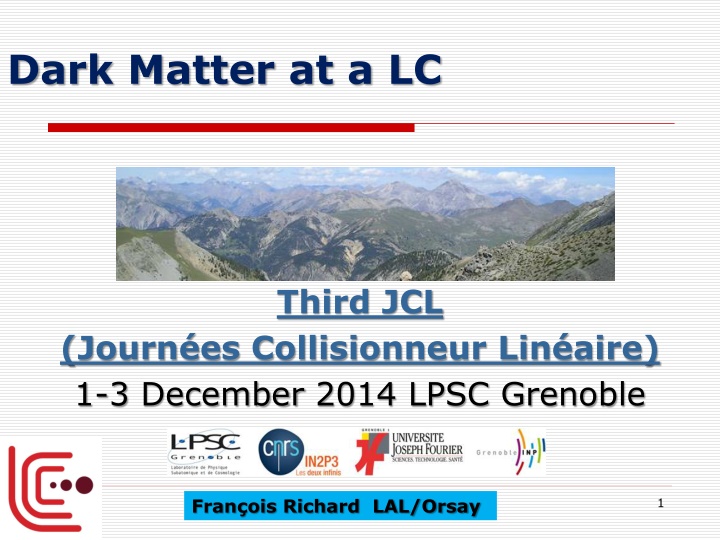
Unveiling the Mystery of Dark Matter at a Linear Collider Event
Delve into the exploration of dark matter at a Linear Collider event in Grenoble, where researchers discuss the elusive nature and potential origins of this enigmatic substance, as well as the methods and technologies being developed to detect and understand it.
Download Presentation

Please find below an Image/Link to download the presentation.
The content on the website is provided AS IS for your information and personal use only. It may not be sold, licensed, or shared on other websites without obtaining consent from the author. If you encounter any issues during the download, it is possible that the publisher has removed the file from their server.
You are allowed to download the files provided on this website for personal or commercial use, subject to the condition that they are used lawfully. All files are the property of their respective owners.
The content on the website is provided AS IS for your information and personal use only. It may not be sold, licensed, or shared on other websites without obtaining consent from the author.
E N D
Presentation Transcript
Dark Matter at a LC Third JCL (Journ es Collisionneur Lin aire) 1-3 December 2014 LPSC Grenoble Fran ois Richard LAL/Orsay F. Richard December 2014 1
Introduction 1 The issue of DM appears as a primordial goal in fundamental physics There is no definite prediction about the origin of the astrophysical observations (e.g. particles from ev to multi TeV scales or even macroscopic objects) Direct searches for wimps using liquid Xe are developing very fast and cover the wimp masses >10 GeV provided that these wimps interact coherently with nuclei ( XA~A ) F. Richard December 2014 2
Introduction 2 Indirect searches detecting photons (Fermi) or positrons tend to observe excesses which could also originate from classical sources, pulsars or supernovae remnants If these excesses translate into Direct signals, one can hope to reach convincing evidence for DM It would however take a collider to understand the origin of these particles In certain cases only a collider can detect DM This is the topic of my presentation, focusing on e+e- F. Richard December 2014 3
Possible approach Assume DM is made of fermions, Dirac or Majorana, without an explicit theoretical origin Assume DM annihilation goes through SM particles Z or H (skipped due to lack of time) or through BSM particles Z or A (axial Higgs in a 2 doublet model) Assume that the coupling is chosen to avoid present Direct limits (no coherent interaction, kinematical suppression when quarks have axial coupling) F. Richard December 2014 4
Couplings While for Z and H the fermion couplings are imposed Z allows to choose a pure axial coupling to fermions not accessible to Direct searches For A an axial coupling to fermions is imposed DM Majorana Mediator Z Interactions X X X X X Direct Yes LHC Yes 5 5 f f f f f X , 5 Dirac Z No Yes , 5 5 Majorana A No Yes f , F. Richard December 2014 5
Z case One assumes a pure axial coupling of Z to SM fermions and a vector coupling to X The annihilation cross section given is by + 2 X 2 m m s = = 2 2 2 2 X X V f v | | | | , 4 g K n g s m cf A ) ( + 2 Z 2 12 ( ) s m f Z Z If one takes SM couplings to fermions (K =1), DM solutions predict an invisible Z (BR >90%) K <1 allows to escape LHC limits on Z gVX has an upper limit due to unitarity F. Richard December 2014 6
FR, G. Arcadi, Y. Mambrini arXiv:1411.0088 Allowed domain K =0.2 K =0.1 F. Richard December 2014 7
Searches techniques Monojets at LHC ISR at a LC For mZ >mZ W exchange dominates Use right handed e- Try to reach the highest polarisation F. Richard December 2014 8
FR, G. Arcadi, Y. Mambrini arXiv:1411.0088 Expected signals Pe-=0.9 Pe+=-0.6 Pe-=0.8 Pe+=-0.3 F. Richard December 2014 9
Comments Clear advantage due to beam polarization Knowing the initial sate partons E/p one can reconstruct the mass of the invisible Z High rate, clean signal providing mass, width and coupling to e+e- Extra assumption: no contribution from Bhabhas ee ee which requires perfect vetoing of electrons in the forward region Worries: arXiv:1006.3402 F. Richard December 2014 10
XXAscenario Fulfills all constraints since it couples axially to SM fermions Mass limit deduced from H at LHC assuming MSSM e+e- HA for tan =5 with mA~mH and H 2h This signal in the 4 b mode is background free since top pairs have only 2b F. Richard December 2014 11
Expected signal mA can be reconstructed as the recoil mass to H 2h Illustrates again the power offered by initial energy momentum constraints and good hadronic reconstruction As with Zh, ILC gives the opportunity to measure Higgs invisible decays for the non minimal sector at the1% level mA=mH=300 GeV 1 TeV 1ab-1. 7000 evts F. Richard December 2014 12
Conclusions High energy colliders could provide a decisive understanding of the origin of DM They are complementary to Direct searches specially when DM interactions with nuclei get suppressed While LHC can identify invisible decays associated to DM, it takes an e+e- collider with well defined energy momentum for bump hunting allowing to identify the underlying mechanism Beam polarization gives a major tool for the invisible Z scenario Measuring invisible modes in the non minimal Higgs sector also fits ideally in an LC scenario F. Richard December 2014 13
XXZff 2 2 X A m | | v + g s = 2 X 4 s m g c = + 2 2 f f v (| | | | )12 n g g FO cf V A 2 Z 2 ( ) ( ) s m f Z Z g c = = 2 W f f ( 2 ) g I Qs g I 3 3 V A 2 2 W W DM annihilation depends on v which decreases from decoupling to present temperatures Needs Sommerfeld enhancement G. Arcadi, Y. Mambrini, FR arXiv:1411.2985 F. Richard December 2014 15
G. Arcadi, Y. Mambrini, FR arXiv:1411.2985 Direct limits F. Richard December 2014 16
Photon excess in Galactic Center Quoting arXiv:1402.6703 the signal is observed to extend to at least ~100from the Galactic Center (GC), disfavoring the possibility that this emission originates from millisecond pulsars . mX 20-55 GeV and even more if XX->WW,ZZ,hh Note the 3.5 KeV line interpreted as DM does not show this angular dispersion Recent dwarf galaxy survey shows a slight tension http://fermi.gsfc.nasa.gov/science/mtgs/symposia/20 14/program/17_Anderson.pdf F. Richard December 2014 17
http://fermi.gsfc.nasa.gov/science/mtgs/symposia/2014/program/17_Anderson.pdfhttp://fermi.gsfc.nasa.gov/science/mtgs/symposia/2014/program/17_Anderson.pdf F. Richard December 2014 18

